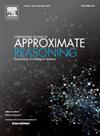弹性灾害响应网络模糊图连通性优化
IF 3
3区 计算机科学
Q2 COMPUTER SCIENCE, ARTIFICIAL INTELLIGENCE
引用次数: 0
摘要
尽管近年来取得了重大的技术进步,但通信挑战仍然存在。这些问题在危机期间尤其明显,在危机期间,系统故障、网络过载以及不同组织使用的通信技术之间的不兼容造成了主要障碍。灾难情景具有信息不确定性高、控制有限的特点,给危机沟通带来了挑战。然而,从网络理论的角度来看,这些方面还没有得到充分的探讨。本研究调查了模糊图中两个节点之间的(x,y)连接参数,提供了对网络结构,鲁棒性和性能的见解。基于对节点到节点连通性的影响,我们将节点和边分为三类:增强、侵蚀和持久。在不同类别的模糊图中分析了这些分类的行为。进一步,我们建立了两种图运算下(x,y)-连通性的上界和下界。提出了一种有效的节点和边的识别和分类算法。我们的分类的实际意义是通过它在灾难响应通信网络中的应用来说明的,其中保持弹性和适应性通信是至关重要的。本文章由计算机程序翻译,如有差异,请以英文原文为准。
Optimizing connectivity in fuzzy graphs for resilient disaster response networks
Despite significant technological advances in recent years, communication challenges still persist. These issues are especially evident during crises, where system failures, network overloads, and incompatibilities among the communication technologies used by different organizations create major obstacles. Catastrophe scenarios are marked by high information uncertainty and limited control, which raises challenges for crisis communication. However, these aspects remain underexplored from a network-theoretic perspective. This study investigates the -connectivity parameter between two nodes in a fuzzy graph, offering insights into network structure, robustness, and performance. We introduce a novel classification of nodes and edges into three categories: enhancing, eroded, and persisting, based on their impact on node-to-node connectivity. The behavior of these classifications is analyzed across different classes of fuzzy graphs. Furthermore, we establish upper and lower bounds for the -connectivity under two graph operations. An efficient algorithm is proposed to identify and categorize nodes and edges accordingly. The practical relevance of our classification is illustrated through its application to disaster response communication networks, where maintaining resilient and adaptive communication is critical.
求助全文
通过发布文献求助,成功后即可免费获取论文全文。
去求助
来源期刊

International Journal of Approximate Reasoning
工程技术-计算机:人工智能
CiteScore
6.90
自引率
12.80%
发文量
170
审稿时长
67 days
期刊介绍:
The International Journal of Approximate Reasoning is intended to serve as a forum for the treatment of imprecision and uncertainty in Artificial and Computational Intelligence, covering both the foundations of uncertainty theories, and the design of intelligent systems for scientific and engineering applications. It publishes high-quality research papers describing theoretical developments or innovative applications, as well as review articles on topics of general interest.
Relevant topics include, but are not limited to, probabilistic reasoning and Bayesian networks, imprecise probabilities, random sets, belief functions (Dempster-Shafer theory), possibility theory, fuzzy sets, rough sets, decision theory, non-additive measures and integrals, qualitative reasoning about uncertainty, comparative probability orderings, game-theoretic probability, default reasoning, nonstandard logics, argumentation systems, inconsistency tolerant reasoning, elicitation techniques, philosophical foundations and psychological models of uncertain reasoning.
Domains of application for uncertain reasoning systems include risk analysis and assessment, information retrieval and database design, information fusion, machine learning, data and web mining, computer vision, image and signal processing, intelligent data analysis, statistics, multi-agent systems, etc.
 求助内容:
求助内容: 应助结果提醒方式:
应助结果提醒方式:


